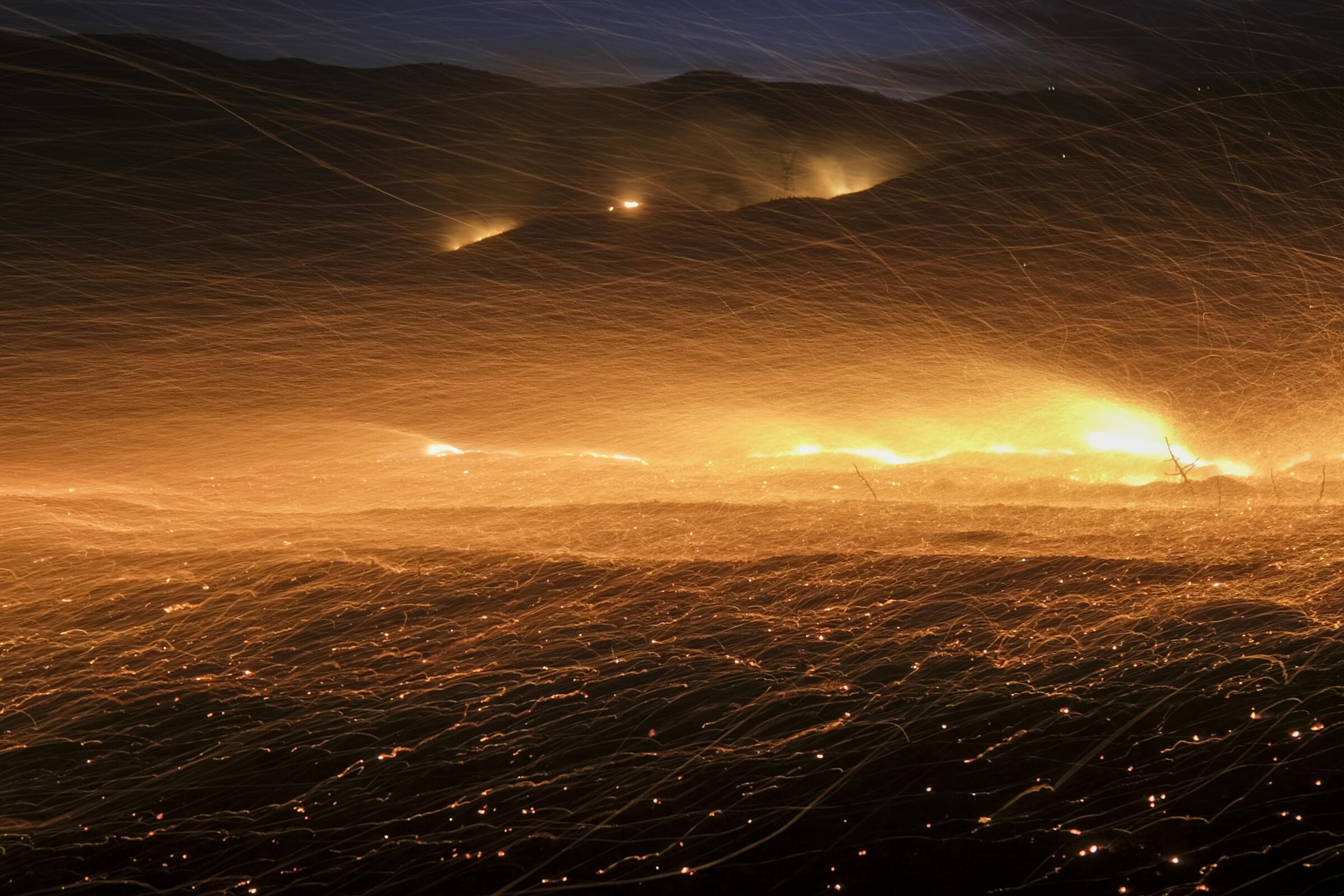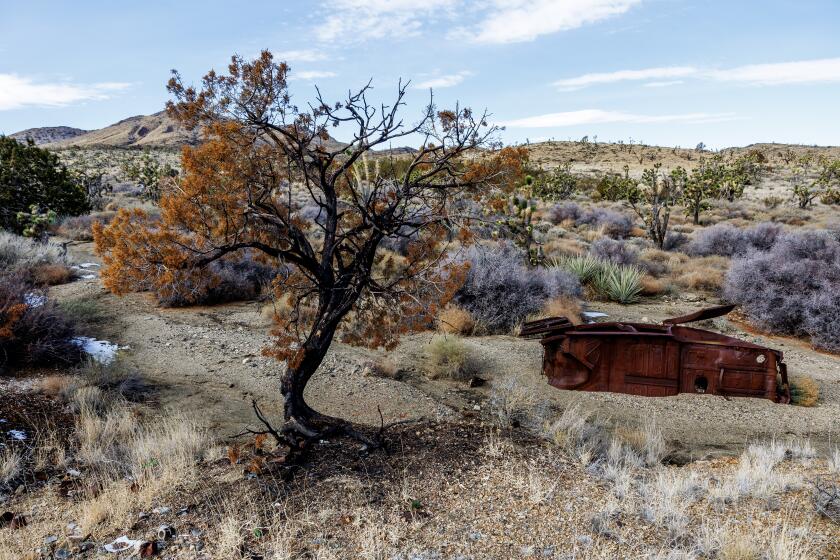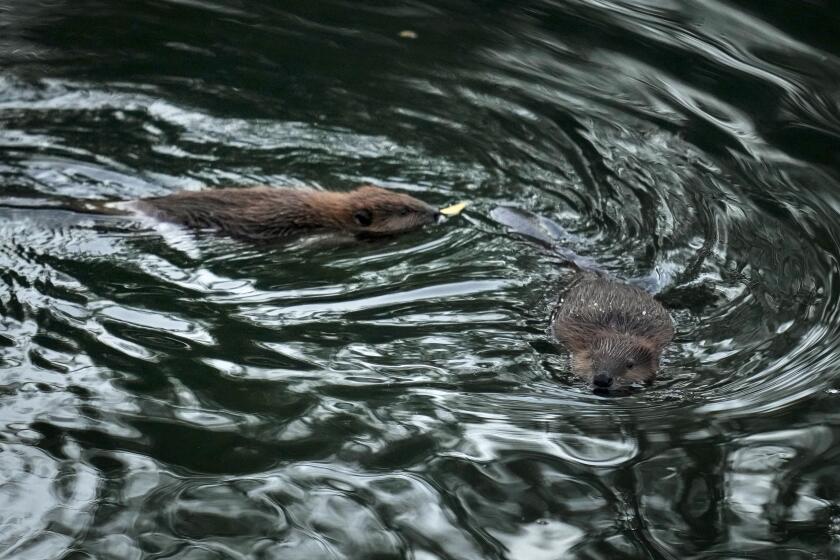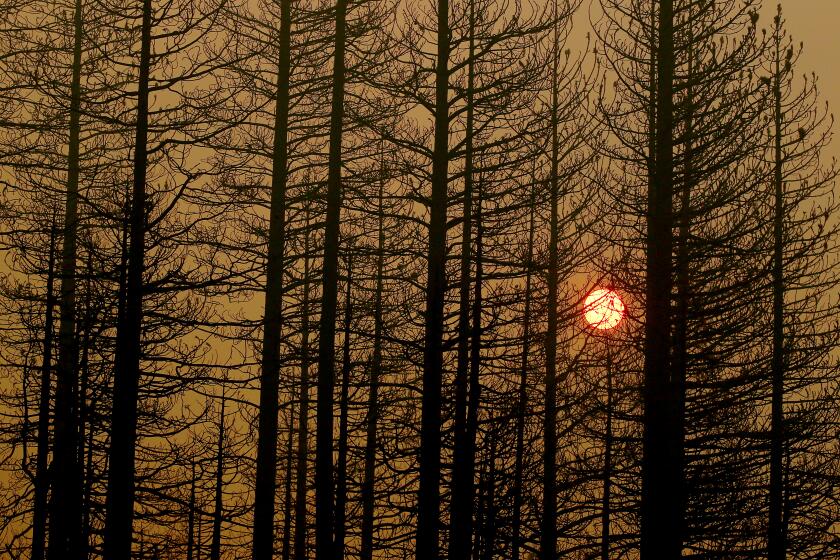Alex Wigglesworth is a reporter who covers the Inland Empire, Mojave Desert communities and the environment for the Los Angeles Times.
- Share via
1
Wildfire weather has become more frequent in the Western United States over the past five decades, with some of the largest jumps in California, according to a new report by Climate Central, a nonprofit news outlet that reports on climate change.
The report looks at three key weather conditions — heat, dryness and wind — that, when combined, load the dice for wildfires to spread quickly and grow large, said Kaitlyn Trudeau, senior research associate with Climate Central.
Aggressive and impactful reporting on climate change, the environment, health and science.
“We’re really talking about days when the stage is set for prime wildfire growth,” she said. “All three conditions are working together to make for really dangerous meteorological conditions.”
The report serves as a good reminder that the Western U.S. has become warmer and drier in ways that tend to promote more large wildfires, said Park Williams, climate scientist and professor in the UCLA Department of Geography, who was not involved in the analysis.
“We’ve seen in tons of academic research over the last decade that fire weather is increasing in the U.S. — and most of the increase has been in the West — over the last half-century or so,” he said. “So this report is very much in line with that general conclusion.”
The burning of fossil fuels has ratcheted up fire danger by increasing global temperatures, Trudeau said. Because warmer air can hold more water, the atmosphere has become thirstier, pulling more moisture from plants and soils and making them burn more readily, she said.
“Because we can attribute that warming to climate change, and because of the relationship between relative humidity and temperature, we know that we can attribute some of this to climate change,” she said.
Danielle Wall has transformed how locals interact with rattlesnakes. Her work has earned her a front-row seat to reshaping of California’s High Desert.
The researchers analyzed hourly observation data from 476 weather stations across the lower 48 states to calculate how many fire weather days were recorded at each station, on average, for each of the last 51 years. They defined a fire weather day as one when temperatures, relative humidity and sustained wind speeds simultaneously reached certain thresholds for at least two of the 24 hours.
The report found the average annual number of fire weather days is increasing throughout the majority of California, especially in interior areas of the state. The southern interior, the state’s portion of the Southwest Desert Basin, saw the biggest jump with an increase of 61 fire weather days per year, on average, between 1973 and last year.
Generally speaking, an increase in fire weather would tend to have the smallest effect on this already very dry, sparsely-vegetated desert region as the warming and drying of the atmosphere doesn’t necessarily promote more fire there, Williams said.
“Instead, actually giving the land some water in order to grow new fuels is the first thing you need for more fire,” he said.
But higher-elevation desert areas that have received healthy doses of precipitation over the last year or two may have enough connected vegetation to sustain a large fire. The basin region includes a corner of the eastern Mojave Desert where the York fire became California’s largest blaze last year.
Last year’s York fire has sparked discussion about how to deal with conflagrations in the Mojave National Preserve.
California’s San Joaquin and Sacramento drainages saw smaller, albeit notable, increases in average annual fire weather days of 14 and 13, respectively, since 1973, according to the Climate Central report.
Parts of New Mexico, Texas and Arizona saw large jumps in average annual fire weather days. By contrast, parts of North and South Dakota, where spring has been cooling slightly, saw a decline, the report found.
There were some drawbacks to doing a nationwide analysis, Trudeau said. There are different ways to define fire weather depending on an area’s local climate, and it was a challenge to come up with a range of criteria that could be used across the U.S., she said.
Toward a more sustainable California
Get Boiling Point, our newsletter exploring climate change, energy and the environment, and become part of the conversation — and the solution.
You may occasionally receive promotional content from the Los Angeles Times.
“Because of that, there are certain parts of this analysis that don’t fully represent the story,” she said.
For example, researchers decided to use regionally specific relative humidity thresholds based on criteria set by the National Oceanic and Atmospheric Administration and National Weather Service’s Storm Prediction Center, which is less than or equal to 20% for a broad swath of the West, including the California coast, Trudeau said.
As a result, the report calculates relatively small increases in average annual fire weather days for California’s regional coasts — four days for the Central Coast, three for the south coast and one for the north.
“It’s not necessarily the biggest picture, because we’re basically asking a coastal area to meet this threshold that is very hard to meet when you’re right next to a large body of water,” Trudeau said.
Still, she said, the fact that there were days when the California coast did get that dry, and that the frequency of those days is increasing even modestly, is meaningful.
“It actually does pick up that these parts of California do experience really bad conditions, where it does get extremely dry even when you’re right by the ocean,” she said.
Beavers create unburned islands where plants and animals can shelter from megafires, research has confirmed. A movement is afoot to reintroduce the rodents to the state’s waterways.
Trudeau also noted that the report does not account for the profound changes in vegetation that have taken place over the last 50 years, as portions of California’s forests were altered by fire suppression, the quashing of Indigenous cultural burning and industrial logging. Nor does it consider the incidence of dry lightning bursts, which have ignited some of the state’s biggest fires, or the extent to which development has pushed into wildland areas, putting more people and properties at risk, she said.
“Our analysis should definitely not be taken as a comprehensive be-all, end-all of what fire risk is in California, or fire weather risk, because there are so many other variables,” she said. “But it gives you a piece of the puzzle.”
Trudeau took a personal interest in the research. She grew up in Placerville, a small town in the Sierra Nevada foothills between Sacramento and Lake Tahoe, and has seen firsthand how warming temperatures have reshaped the landscape. “I’ve seen the seasons change, I’ve seen the fires come, I’ve seen how we got a lot less snow, a lot less rain,” she said.
“Just being a Californian and spending most of my life out here, the results really follow what we’re seeing, and follow my experience living in this awesome part of the world that has, unfortunately, a really immense and growing risk.”
North America’s 2021 fire season, including massive Northern California blazes, was made worse by a supercharged heat dome. What did the supercharging? Climate change.










